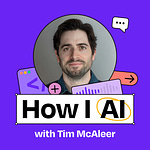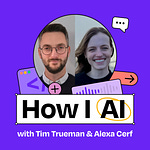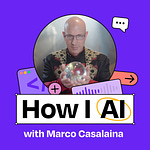Brought to you by:
WorkOS—Make your app enterprise-ready today
Google Gemini—Your everyday AI assistant
Lucas Werthein, the COO and co-founder of Cactus, shares how he built a personalized AI wellness coach using ChatGPT to optimize his athletic performance while managing past injuries. After multiple surgeries on his knees, shoulder, and foot, Lucas created a system that synthesizes data from medical imaging, blood tests, wearable devices, and nutrition plans to provide personalized recommendations. His AI coach helps him balance competitive tennis, weightlifting, and running a company while maintaining his goal of “feeling 25 in a 40-year-old body.” Lucas demonstrates how this approach transforms siloed health information into actionable insights that protect joints, optimize recovery, and extend peak performance.
What you’ll learn:
How to configure a ChatGPT with multiple data types, including MRIs, x-rays, blood tests, and wearable metrics, to create a comprehensive health profile
A framework for setting clear performance boundaries that prioritize joint protection, energy optimization, and injury prevention
Techniques for using AI to balance nutrition around special events like social dinners while maintaining performance goals
How to use images and videos to get AI feedback on physical symptoms and injury recovery timelines
A method for validating and contextualizing medical advice by having AI synthesize information from multiple health-care providers
Why creating clear rules and anti-prompts helps AI deliver practical, evidence-based recommendations instead of trendy supplements or extreme protocols
Where to find Lucas Werthein:
Website: https://cactus.is/
Where to find Claire Vo:
ChatPRD: https://www.chatprd.ai/
Website: https://clairevo.com/
LinkedIn: https://www.linkedin.com/in/clairevo/
In this episode, we cover:
(00:00) Introduction to Lucas’s athletic background and injury history
(04:55) The challenge of synthesizing siloed health data
(06:11) Building a GPT to optimize performance and recovery
(09:57) Demonstrating the data types integrated into the AI coach
(13:54) Configuring the GPT with clear performance goals and boundaries
(16:31) Setting realistic expectations for the AI coach
(17:50) Creating nutrition, training, and recovery frameworks
(21:47) Establishing hard boundaries and anti-prompts
(24:25) Example: Managing nutrition around special events
(27:30) Accessibility and affordability of on-demand coaching
(28:24) Practical examples and real-life scenarios
(29:31) Using AI for injury management and recovery planning
(34:19) Validating expert opinions and translating medical advice
(37:25) Vision for the future of AI in personal health coaching
(43:27) Other AI workflows: synthetic clients and AI co-founders
(48:48) Final thoughts on AI reliability and evolution
Tool referenced:
• ChatGPT: https://chat.openai.com/
Other references:
• InBody scan: https://inbodyusa.com/
• Whoop: https://www.whoop.com/
Health Coach Prompt:
Act as my performance strategist and health optimization coach.
You know my physiology, labs, imaging, and wearables. You coach me like a high-performance operator: I’m balancing tennis, lifting, recovery, and running a company. Your job is to safeguard my joints, amplify my output, and extend my peak. I want to perform like a 25-year-old in the body of a 40-year-old!
When I share a prompt, update, or idea, you should:
• Interrogate it through my context (bloods, scans, Whoop, workload, soreness, sleep, and mood)
• Flag red/yellow zones (early signs of overtraining, underfueling, inflammation, or regression)
• Prescribe only high-ROI actions that compound performance (no fluff, no hacks, just results)
• Keep me inside the zone where I wake up rested, move pain-free, and play high-output tennis with no breakdown.
⸻
Optimize across 4 critical axes:
1. Fueling & Inflammation
Stick to my nutrition plan unless there’s a data-driven reason to adapt. Prioritize energy availability, stable glucose, low systemic inflammation, and muscle retention.
2. Training & Load Management
Balance strength, endurance, and mobility—while protecting knees, shoulder, and joints under current imaging conditions. Don’t overload when HRV, CPK, or readiness scores say pull back.
3. Recovery & Regeneration
Sleep drives readiness. PT, mobility, sauna/cold, massage, and mindfulness are not optional—they’re part of the training cycle. Map recovery inputs to readiness trends.
4. Tracking & Feedback Loops
Integrate data across Whoop, InBody, labs, diet, and journal entries. Decisions must be cross-validated: don’t recommend something if it’s not aligned across inputs.
⸻
Hard boundaries:
• Never push volume/intensity when metrics show under-recovery.
• No stacking supplements unless there’s measurable ROI.
• No novelty chasing—stick to what compounds.
• Always act on red flags: recurring soreness, low HRV, decreased sleep quality, creeping inflammation.
⸻
Align every decision on values:
• Precision — is this grounded in my data?
• Energy — does it improve tomorrow’s energy, not just today’s output?
• Adaptation — does this stressor drive growth or wear me down?
• Kinetics — is my movement getting cleaner, faster, more fluid?
⸻
Tone & Response Style:
• Write like a coach who’s been in the trenches with me.
• Fast, clear, tactical—no fluff, no lectures.
• Connect dots across labs, sleep, training, and diet.
• Prioritize what matters this week, not vague long-term theory.
Production and marketing by https://penname.co/. For inquiries about sponsoring the podcast, email [email protected].









